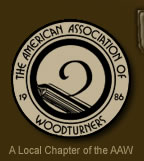WVWA club members are interviewed in this "Turner's Shop" series. In addition to questions about their background in woodturning and their interests, photos of their shop and equipment are included.
Cliff Baker: Lewisburg

Safety is important when I am turning- I wear a Trend Air Shield respirator and face shield, ear protectors, and a nylon shirt with elastic cuffs. A friend made a 1 3/8" pin chuck that I use to turn the outside of a bowl and I always use the tailstock for extra support. Most chuck manufacturers offer pin jaws that could also be used. Once the blank has been aligned on my drill press table and the hole has been drilled, the pin chuck and hole ensure that the blank will be properly aligned on the lathe.

I use a 16"x40" Woodfast lathe with a 1 1/2 HP variable speed motor and a Vicmarc chuck.

My "go-to" tools are a 1/2" bowl gouge for rough turning and a 3/8" bowl gouge for taking finish cuts. The bevel grind is 40 degrees and the wings are short.

It's easy to use wedges to align the blank so the ends and edges of the finished bowl are at the proper height. The hole will align the blank on the lathe.

I use a jig with a 1 3/8" peg to cut the blank. A wedge-shaped block supports the rounded blank during cutting.

The blank is locked on the pin by a short rod on the milled flat. I always use the tailstock to stabilize the workpiece.

The short wings of the gouge allow a large shaving to be cut. On the right you can see the width of the cut being made.

I made a vacuum chuck from a turned wooden adapter, two sealed ball bearings, a 1/2" nipple, and a length of 3/8" threaded tube. Using an appropriate chuck, I can turn off the tenon and finish the base.

I made several chucks using faceplates, wood, PCVC pipe, and sealing discs cut from large inner tubes. A gasket, washer, and nut seal the vacuum tube to the chuck.

My favorite form for turning is a natural-edge bowl that ahows off the character of the wood. This 9" bowl was turned from a piece of crab apple that I found in a firewood pile.
Interview
How did you get started with woodturning?
My first encounter with woodturning was in seventh grade wood shop. Our assignment was to turn a belaying pin from white pine using a skew chisel.
What is your favorite source for tools and supplies?
I order most of my tools and project supplies from Packard Woodworks or Craft Supplies since they represent different suppliers. I get most of my sanding supplies from The Sanding Glove because they sell Norton abrasives which I find are more durable than other brands.
What would you like to learn next?
I would like to learn how to incorporate texture into my turnings. My goal would be to have the texture enhance the grain and color of the wood rather than use the turned form as a canvas for applying texture texture.
What turner inspires you?
I watched several demonstrations by Mike Jackofsky at the AAW Symposium in San Jose. I was very impressed with how he combined his artistic talent and technical competence with the ability to provide a great deal of practical advice to turners of all skill levels.
What is your most prized turning?
I have several: one is an oak burl bowl resting in a base made of wrought iron oak leaves and acorns; another is segmented bowl with the lower layer made of 24 sassafrass segments; a third is a natural-edge bowl turned from the crotch of an old crabapple tree that has several cracks and worm holes.
Other than your lathe, what machine do you use most in your shop?
In addition to wood turning, I enjoy making furniture based on Shaker and other antique designs. A radial arm saw and a jointer are the machines I use most.
by WVWA, a chapter of the American Association of Woodturners

